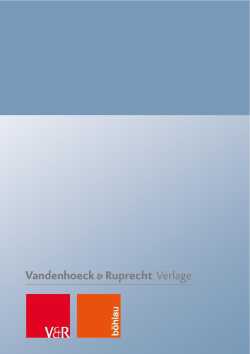The author distinguishes two different perspectives of human destiny: a duality of salvation and damnation, and the apokatastasis or restitutio ad integrum, in site of the condemnation of the latter approach in which eventually all souls will be saved and God will be «all in all». The first chapter consist of an overview of the theologians who allow for salvation for pagans, such as Clement of Alexandria and Origen. The well-known judgment scene in Matthew 25: 31–46 should deserve a more thorough analysis: not only the wicked but also the just did not know that they had met the Son of man in the poor and the sick. Apparently, the decisive element is not belief but deeds!
Although the early Christian writers still felt the criticism of the gnosis: how can your God damn all people before Christ or outside the Church? The official Church theology was quick to choose the hard exclusive line. Theology in the East has preserved more of the apokatastasis than the West, the latter strongly influenced by the late Augustin with his emphasis upon damnation. The book becomes exciting when it claims a hidden presence of the apokatastasis in the West as well: in art, in narratives, such as about the virgin Mary’s descent in to hell to search for lost souls, or in Dante’s struggle with Virgil’s fate as doomed. An even more striking example may be found in Purgatorio X,76: the emperor Trajan had helped a widow and because of that his soul was allowed to return into his body to be baptized. Eventually he had been vouchsafed the eternal bliss!
In the Reformation a similar constellation takes place: officially there is no room for salvation for non-Christians, or even non-Protestants, but some mystical and Pietist circles defend universal salvation. A different but likewise strong advocate of universal salvation was the Enlightenment. Obviously, intolerance and religious chauvinism had a hard time. By far the most surprising chapter has been preserved for the last: the universal salvation in the music. Wagner’s Kundry, although resembling the traitor Judas, achieves some sort of repentance, not unlike Judas in the narrative of Brendan’s Navigatio. Mahler and Orff felt also attracted to the concept of restitutio ad integrum and universal heavenly bliss.
Although Horst Weigelt rightly points to modern developments in theology, such as the Va¬tican declaration Nostra Aetate, it remains a pity that he has not adduced interreligious data. The question of salvation for the Jews or more general: salvation outside the Church is closely related to the apokatastasis. Francis Sullivan’s book Extra ecclesiam nulla salus forms as it were a companion volume to Weigelts’ book (in which the German authors are by far in the majority). Clement of Alexandria may turn out to be more than just an unsystematic thinker: his openminded appreciation of Greek culture forms a lasting element in Catholic theology: the «spolia Egyptiorum», the gold and silver from Egypt, are possible source of idolatry (Golden Calf!), but are also suited to the service of God (the tabernacle). Ironically, the Catholic church has branded the idea of damnation of all people outside the church as heretical, as has become clear in the «affaire of Feeney s.j.». In another way the interreligious dimension could have been of help: the Jewish concept of hell lasting only twelve months is remarkably similar to the Medieval concept of purgatory. Still, the original contribution of this book lies in the opening of new vistas: in Eastern orthodoxy, in folk narratives, in Western mysticism and in art.
Zitierweise:
Poorthuis, Marcel: Rezension zu: Weigelt, Horst: Universale Heilshoffnungen im Christentum. Apokatastasisideen in Theologie und Kirche, Literatur und Musik, Göttingen 2021. Zuerst erschienen in: Schweizerische Zeitschrift für Religions- und Kulturgeschichte, Vol. 116, 2022, S. 487-488. Online: https://doi.org/10.24894/2673-3641.00127.
